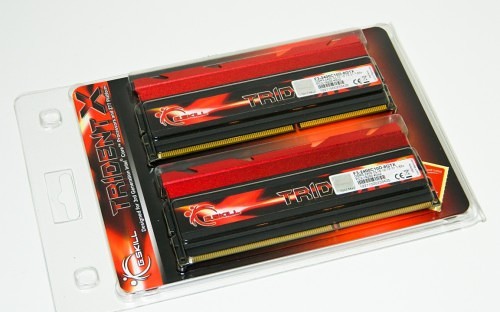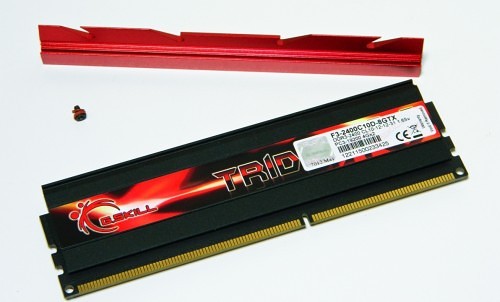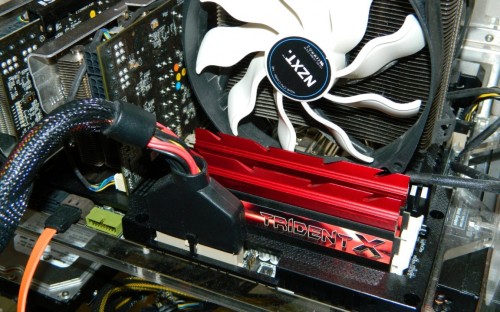It’s been a while since I put a few elite overclocking DDR3 memory kits to work on any these pimped out Intel Sandy Bridge and Ivy Bridge test systems. While overclocking the memory itself won’t give you any gains, overclocking the CPU at the same time is what allows you to use that bandwidth. You have to do both and that’s when a memory kit like the G.SKILL TridentXX 2400MHz DDR3 8GB dual channel memory kit comes in handy, offering you the best IC modules which also allow for tighter memory timings, if you choose to downclock them, for better system response. Let’s see how tight and fast we can get these modules to run today.
G.SKILL TridentX 2400MHz Features and Specs
The G.SKILL TridentX kit features a removable crimson red heatsink extension on top of a black spreader, sporting matching G.SKILL branded stickers. The red tops are actually pretty simple in detail but contrast really well with the black spreaders. Removing an end screw allows users to slide off the red cap to shorten them up a bit more in case your CPU fan needs the space or maybe you just like jet black and no red. Too bad the G.SKILL emblem and name aren’t etched in to the heat sinks. That would look pretty sick and original.
As for specs, it’s pretty standard for most Z68 and Z77 motherboards to support DDR3-2400 with minimal issue. The programmed XMP profile should default to 10-12-12-31 timings using only 1.65 volts assuming your motherboard’s BIOS is up to the task. You can see that these are all “tested” specs meaning G.SKILL can guarantee this operational performance. However, it’s not uncommon to see their high end modules like these achieve even better results with little to no voltage increase. In other words, the timings might be able to hit 9-10-10-31 or so. We’ll find out if this $99 US/CA kit can do more in testing.
Those who need more than 2400MHz will find the TridentX series tops out at 2600MHz in 8GB, 16GB (dual and quad channel) and 24GB (triple channel) kits. In all reality, this is the maximum sweet spot since very few motherboards are capable of supporting that frequency and only a couple capable of even more. Yes, we’re on the hairy edge of CPU melting these days.
Test System Setup
Since, few boards can truly support 2600MHz XMP profiles, I’ve selected one capable of an impressive 2800MHz. I’m curious if the memory runs XMP tested specs as well as CAS9 timings or higher frequencies. Again, your motherboard’s BIOS will absolutely vary and probably require some fine tuning if the XMP profile doesn’t hold.
- Processors: Intel Core i7-3770K Ivy Bridge
- Cooling: Koolance Exos 2.5 w/DangerDen MC-TDX Block
- Motherboard: ASUS Sabertooth Z77
- Memory 1: G.SKILL TridentX 8GB 2400MHz Dual Channel DDR3
- Memory 2: Kingston HyperX 8GB 1600MHz (from Quad Channel) DDR3
- Graphics: MSI GTX 560 Ti SLI
- Power: Antec TruePower Quattro 1200 Watt
- Storage: Kingston HyperX 120GB SSD
- OS: Windows 7 64-bit Pro
The motherboard’s BIOS was left to optimal settings which naturally enables Intel Turbo 2.0 which scales to 3.9GHz. Both XMP profiles and manual memory settings were used to compare stock Intel supported memory frequencies (1600) to overclocked frequencies.
Why Doesn’t Overclocking Memory Alone Help?
In the simplest of terms, overclocking just the memory basically just overclocks the Intel Ivy Bridge processor’s integrated memory controller (IMC) and not the cores. Since the CPU cores do the bulk of the work, they influence system performance the most. Think about it like it’s a car. The engine (CPU) only puts out a certain number of horse power. You can give it the sweetest racing tires on the planet but the horse power isn’t going to go up. However, if you upgrade the engine, those racing tires (memory) will support that extra horsepower and get you around the track quicker.
Since overclocking memory tends to be the prettiest and uses the best IC modules around, I often use it inside demo systems to show the motherboard’s capabilities and in my personal systems, but downclocked and with lower, but tighter, CAS Latency (CL) timings to improve system responsiveness. The G.SKILL TridentX 2400MHz work perfectly at 1600MHz 7-8-8-24 (CAS7) and are faster than 1600MHz 9-9-9-27 (CAS9) memory because of those lower timings. Unfortunately, I was unable to get the memory to run 1600MHz CL6 timings most likely due to the limitations of the Ivy Bridge IMC.
Memory Bandwidth – What’s on Tap?
Big programs can be written and read to RAM very quickly. The more RAM you have, the easier it is for the system to find a place for it all. The memory module frequencies and timings on each of the TridentX’s sticks reach speeds of 2400MHz. To see what kind of bandwidth the processor’s integrated memory controller can pull from the TridentX, I’m using SANDRA’s memory bandwidth benchmark.
First, you can see the benefit of lower CL7 timings over CL9. This is one benefit of running TridentX at the slower frequency with better timings. Note the 1600-CL7 performance when the CPU is overclocked. However, if your processor needs more speed for massive files, the 2400MHz bandwidth is about 8GB per second faster!
Game Performance at 1600-2400MHz
Just for confirmation, I ran Aliens Vs Predator benchmarks and Unigine Heaven 3.0 benchmarks both of which are DX11. Screen resolution was 1440 x 900. Unigine was using 8x/8x AA/AN sampling with normal tessellation.
Memory frequencies alone had no effect on the frame rates. The video cards are doing all the work. Depending on the game title, overclocking the CPU can typically creates some gains. If you’re just gaming and have no plans to push your CPU and memory in unison, you’re better off buying some TridentX 1600MHz memory, and saving the money for another game title.
GraySky 4.0 H.264 Benchmark
Since we indeed live in a media age, I used the Graysky 4.0 H.264 benchmark readily available for free download for those curious about their own system’s performance. Let’s see how the TridentX 2400MHz does compared to stock frequencies and timings.
There was a slight gain when running 2400MHz. There was also almost no performance difference between CAS7 and CAS9 performance. One reason for this is that the CPU is very efficient using its own cache and doesn’t often have to go hunting for RAM access. Therefore, there really isn’t much of a need for tighter timings in kits these days.
PCMark7
I’ve often wondered if memory influences a system’s overall performance in PCMark7 which measures such things like media, web and calculation. For this test, I selected productivity and computation tests in order to isolate any gains from memory frequencies.
CAS latency and CPU frequency benefit the synthetic benchmark. Higher latencies take longer to read and write program benchmark data to and from the RAM while tighter timings do it quicker. When the TridentX 2400MHz is paired with a 4.3GHz overclock, it does much better.
CINEBENCH R11.5
I’ve used this public benchmark before to show variances in memory timings and CPU frequencies especially when overclocking. Let’s see what timings and frequencies make the biggest difference.
When it came to scoring, memory timings made all the difference over frequency and heavily influenced the processor performance. Using the TridentX 2400MHz at 1600MHz CAS7 provides the best overall system performance even if not overclocking.
Final Thoughts
Every time a new processor launches, new supporting RAM also launches to the corners of the tech world. And, each time that happens, I’m fortunate enough to get the chance to validate many different make and model memory kits. As it stands, the G.SKILL TridentX X 2400MHz 8GB DDR3 dual channel memory kit is the latest to earn a spot on my extremely recommended list in support of Intel’s Ivy Bridge processors. The TridentX X’s XMP settings worked on any of the ASUS, GIGABYTE, MSI and ASRock motherboards.
The great things about working with the 2400MHz TridentX X is that it looks great, has a removable red fins making it an adaptable low profile kit, matches 2400MHz specs and can be clocked down with much better timings that you just can’t get from budget or lower frequency modules. As far as overclocking memory goes, the TridentX X 2400MHz is stable and all around ready to rock. If this sweet red X fits your high performance system, you can find it for between $100 to $115 at the usual places like NCIX or Newegg.
Overall, I’d recommend these modules to anyone wanting the option for very tight timings or higher clock speeds, and also give it a distinction of being one high performance product.
Pros
- High quality 2400MHz modules
- Great looking memory kit
- Adaptive-Low Profile heat sinks (Removable red fins)
- 2400MHz XMP performance
Cons
- Would be exceptional with tighter than CAS 10 timings (at 2400MHz)
Overall Rating: 9.0 / 10.0
Help Us Improve Our Reviews By Leaving a Comment Below!



